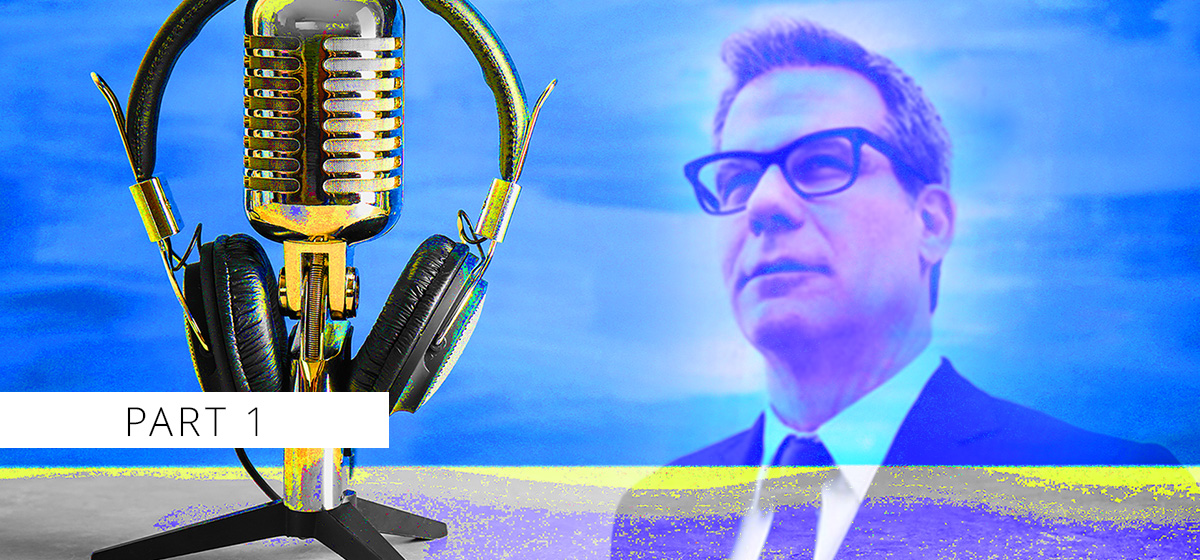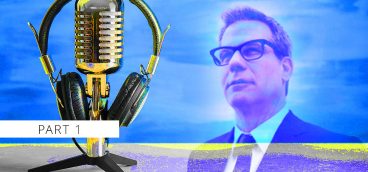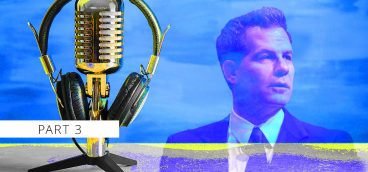Pittsburgh Tomorrow Podcast: Richard Florida, Author, “The Rise of the Creative Class” (Part 1)

Donald Bonk interviews Richard Florida, influential professor, author and urban theorist, as part of the Pittsburgh Tomorrow podcast series. This is the first part of a three-part interview. The transcript is abridged and edited for clarity.
View the episode archive here. Read Richard Florida’s Creative Class bio here. Read his University of Toronto bio here.
“…we’ve studied the location of industries and firms for a century, but we really haven’t studied from an economic geography point of view, from an urbanist point of view, the location decisions of people. That was my motivating question. Why do we as people choose to live in the locations we do?” —Richard Florida
Donald Bonk: Welcome to a very special edition of Pittsburgh Tomorrow with Richard Florida, influential professor, author and urban theorist. Welcome, Richard.
Richard Florida: It’s great to be with you, Donald. Thanks for having me. And it’s great to be back in Pittsburgh, if only virtually.
Bonk: Well, we’re happy to have you here. You know what Pittsburgh’s going through (COVID-19), as is the rest of the world right now, but we really want to focus first on the city of Pittsburgh and also your background; what you’re doing and your connection to Pittsburgh.
Florida: Well, I moved to Pittsburgh in 1987 and I was 29 years old at the time. And it’s an interesting story. I was teaching at Ohio State (I’m originally from Newark, N.J.). I got enough money to do a lecture series. I invited all of the eminent urbanists of the time, and they agreed for very small honoraria, to come give a talk in my lecture series.
There was a very eminent urbanist at Carnegie Mellon at the time, in what was then called SUPA, the School of Urban Public Affairs (now the Heinz School); his name was Gordon Clark. As it turns out, Gordon is now the Mackinder Professor of Geography at Oxford University. He went to graduate school in Canada, was at Harvard, was at the University of Chicago and moved from the University of Chicago to SUPA at Carnegie Mellon.
At the time, Carnegie Mellon was looking to hire a professor jointly between SUPA and Architecture, and they had had many eminent people out, that the two departments couldn’t agree on. Very famous people. But Architecture and SUPA are very different places. Gordon said, “Why don’t you come out and interview for this position?” I always heard a lot about the so-called Pittsburgh Renaissance and the comeback of Pittsburgh as an innovative center, artistic center, a great city of neighborhoods.
I went out, and lo and behold, people liked me, even though I was I was different than anyone because the people in SUPA were very technically quantitative. And the people in architecture were architecturally good. I’m a qualitative researcher; I’m not a quantitative researcher. I’m not very numeric or mathematical, but they sort of liked me.
They offered me a job and I said, yeah. Dick Cyert was president of Carnegie Mellon. I forget who else was involved in it; but Dick (President Cyert), for sure, I know (Angel) Jordan was the provost. My dean was Alfred Blumstein.
Anyway, they had a major gift from John Heinz II, who was still alive, and Senator John Heinz III, to establish a center for economic development. Carnegie Mellon had all this capability in science, technology, computer science, electrical engineering, metallurgical engineering and material science. And the idea was to think about the ways to connect that to the economic future of Pittsburgh. I was brought in to help build that, as this young 29-year-old assistant professor.
I was thrust into a vortex of forces that were acting on Pittsburgh in the late 1980s. My growing up in Newark, N.J., and experiencing the civil rights movement and racial unrest, convinced me to be an urbanist as a young boy. I got a college degree at Rutgers (and later a Ph.D. at Columbia in urban studies). Those things and my life in Pittsburgh, where I lived for nearly 20 years, really shaped me as an urbanist.
Bonk: Very interesting—the power of serendipity in many cases.
Florida: Yeah. As a young single guy living in Shadyside, I could walk or bike or take a car to the university. And remember, at that time, this is really interesting; well before I wrote “The Rise of the Creative Class,” SUPA (CMU School of Urban and Public Affairs) was not in the building in Hamburg Hall. SUPA was in a second or third floor, up the stairs in Margaret Morrison Carnegie College. We were embedded with the arts and dance students.
I still remember my secretary. We had secretaries at the time and my office was lined with file cabinets because we still had paper centric offices.
My secretary, Mary Joyce, was this wonderful woman who supported a half dozen of us. She would say she was always hesitant to go to the restroom because there would not only be girls from the arts and dance program changing in there but there would be boys. Everybody is in the arts. They didn’t care; they were artists.
But the point is that SUPA wasn’t in computer science or electrical engineering. Our department was actually, literally in the creative hub of Margaret Morrison Carnegie College. Quite an introduction for me to Pittsburgh.
Bonk: It obviously played a role in your later theory. It’s just interesting that your foundational experience on a physical level was exposure to the other side of Carnegie Mellon.
Florida: It was a long evolution from when I came to Carnegie Mellon to “Rise of the Creative Class.” It was a dozen years that I was at Carnegie Mellon before I even began to think in that way, shape or form. It was a long intellectual evolution shaped by my experience in Pittsburgh and at Carnegie Mellon, for sure.
Bonk: That gives us a deeper insight into your career that followed. You had this transformational insight around the turn of the century. Can you tie that to what you’ve been doing since then? So you were at Carnegie Mellon at the time. “The Rise of the Creative Class” became an international New York Times bestseller.
Florida: First of all, I had written several other books that were international non-sellers, and I fully expected “The Rise of the Creative Class” to not sell, other than my parents buying it, my brother and some relatives and friends. I didn’t write that book to be a bestseller; I just got really lucky.
As any musician will tell you who has had a hit, they just wrote a lot of other good songs and got lucky. The timing was right. The mood was right. Something happened. Somebody wrote a story on it. I got lucky. And I had written a bunch of other books since and that haven’t done as well, so I think I’ve got a great stroke of luck, but shaped by Pittsburgh.
When I came to Carnegie Mellon, I was thrust into the Center for Economic Development. I had been researching high tech industry complexes like Silicon Valley and Boston Route 128 and what happened in the Research Triangle (North Carolina). I had been studying at Carnegie Mellon with a brilliant economist named Wes Cohen, who’s now at Duke.
We had been studying university industry partnerships and had a big grant from the Ford Foundation. University Industry Centers, National Science Foundation Centers—all the stuff that Carnegie Mellon does spectacularly well.
At the same time, I was immersed in Pittsburgh. I was literally talking to the mayor. The mayor tells funny stories about me. Former (Pittsburgh) Mayor Murphy says he often introduced me by saying, “Richard came to our office talking about the role of universities, and the knowledge and innovation in these research centers. We thought he was from the moon; we thought he was just completely bonkers.”
But I was puzzling over what I’d call the Pittsburgh paradox. Why, when I looked at Stanford, M.I.T. and Carnegie Mellon, did they look like analogous institutions? Why was Carnegie Mellon producing fantastic research? It was actually, at that point, not (yet) spinning off as many companies into the local environment at the rate of M.I.T. in Boston and Stanford in the Silicon Valley.
The people I was meeting at Carnegie Mellon were going to lead those companies. The head of research at Microsoft was a Carnegie Mellon guy, and the head of research at Apple was a Carnegie Mellon guy. People who were going to what ultimately became Google were from Carnegie Mellon. I see all this flow of people, but Pittsburgh hadn’t developed that high tech industry complex. Why?
So I went off to do a sabbatical at Harvard. By this time, I had gotten notorious enough. I hadn’t written “The Rise of the Creative Class,” but I was a young scholar, about 38, 40, and I was invited by a very eminent guy named Harvey Brooks. Harvey was the Benjamin Franklin Pierce Professor of Physics and Applied Engineering, who had really established that unit at Harvard. He was a scientist and engineer and had gone off to establish the Program for Science, Technology and Public Policy at the Kennedy School at Harvard.
He had recruited the former head of NASA to join him. He had recruited the former head of science at IBM, Lewis Branscomb, whose father, Harvey Branscomb, was the president of Vanderbilt. I mean, it was like a Who’s Who of America. There were Nobel Prize winners that were populating this, and they brought me up there because they looked at Pittsburgh. Plus, Florida is an interesting guy. But look at what’s happening in Pittsburgh and the rise of Pittsburgh around Carnegie Mellon. Is that a case that we could use to talk about the role of science and technology university research, to revitalize an older Rust Belt industrial city?
I was writing up my book chapter when I got to the story that I told in “The Rise of the Creative Class.” I read a story in The Boston Globe which said Lycos (a Search Engine), one of the startups out of Carnegie Mellon, founded by two Carnegie Mellon people, was moving to Boston. I said, “Whoa, why?”
A lot of us had paid attention, a lot of people in the Office of Technology Transfer and Commercialization (at Carnegie Mellon); I, and others, had paid a lot of attention to Lycos. When we began to really dig into it, Lycos was moving to Boston to get access to a talented pool of people that they said were already living in Boston, not just techies.
There were marketing people and management people and all the people that they needed for the business—the whole ecosystem necessary to grow a company. That’s what tipped me off. I went back to my students in the fall and said, “How many of you will live in Pittsburgh when you graduate?” Only one hand went up.
Well, (I asked the students), where do you want to go? I want to go to Silicon Valley. I want to go to New York. I want to go to Austin. I want to go to the North Carolina. I don’t like Pittsburgh. It’s not for me, it doesn’t fit me—blah, blah, blah, blah, blah, but you know all that stuff. But then, why? Why do you want to go there? Well, because it’s a place I can make friends. I could have friends if there were more people like me. And that started the train of thought.
Nobel Prize winner Herb Simon had always told me, “If you find a question nobody else asked, if you’re lucky enough, go with that freaking question, Richard.” So the question I said is, we’ve studied the location of industries and firms for a century, but we really haven’t studied from an economic geography point of view, from an urbanist point of view, the location decisions of people. That was my motivating question. Why do we as people choose to live in the locations we do?
And what are the factors that bear on this? And out of that, out of like three or four years of really horrific hard work, I came up with what we now know as “The Rise of the Creative Class.” It really was steeped by my experience with Pittsburgh and trying to answer that question.
What happened since? I can never get away from the heartland. I went off and I lived in Washington, D.C. for three years. That was fun. I developed my relationship with Brookings, with The Atlantic, which ultimately led to the formation of CityLab. George W. Bush got elected, an opportunity happened in Toronto.
I always liked Toronto. It’s close to my wife’s family in Michigan. My wife’s family is in the Detroit suburbs. It came with a big research budget to move up to the Rotman School of Management at the University of Toronto. By the way, there were Carnegie Mellon people who had been clueing me in about Rotman.
They had a dynamic young leader named Roger Martin. They had hired a few people, not from SUPA, not from the Heinz School, but from what was then GSIA, the business school, now the Tepper School at Carnegie Mellon. So it came with a $10 million dollar funding program for ten years. And I couldn’t turn it down. So I ended up in Toronto, which is where I am now.
Bonk: Just a sidebar: Marshall McLuhan was always a big influence on me. He had mentioned in some of his books that Canada was a great place to look at the United States in particular and look at ideas because it’s involved in a big part of things, but it’s also removed.
Florida: I’ll tell you right now that the middle of the COVID-19 crisis, it is surreal. It is. I’ve always said, quoting McLuhan, that moving to Toronto has helped me learn more about the United States than I ever thought I would because of exactly what you said. You see the two countries in sharp relief.
But, boy, when you look at the dysfunction in our country now and you look at the way we pulled apart compared to the Canadians and Torontonians that have pulled together…I just want to say this: Canada is a very divided country. It has a very liberal Prime Minister who would be very, much further left than Clinton or Obama. We have a Premier, which is our equivalent of a Governor, who’s a kind of a Trumpist populist. His brother was Rob Ford, the crack mayor of Toronto. And we have a mayor in John Tory who wouldn’t be elected in Pittsburgh. He would be a Republican. He’s a conservative. But he is a business conservative, kind of like Mike Bloomberg. Some of them literally hate one another. Yet everyone has worked together and now we’ve almost eliminated the virus.
One other thing I’ll say: There’s another Pittsburgh-Toronto connection that bears mentioning on this podcast in the times we live. Toronto is now known alongside Pittsburgh as one of the great artificial intelligence capitals of the world and in many respects, maybe now in some segments more than Pittsburgh, even though Pittsburgh was the birthplace, with Raj Reddy and Herb Simon and Alan Newell.
There’s a fellow named Geoff Hinton. Geoff was at Carnegie Mellon as a professor. He’s a Brit who is pretty left-leaning as many Brits are. In 1980, he saw the United States going off on a wrong track. It elected Ronald Reagan, rightly or wrongly, and more than that, he saw defense funding becoming the principal source of funding for artificial intelligence.
He said, before the University of Toronto was what it is today, “I’m leaving the United States. I’m moving to Toronto.” This one guy, Geoffrey Hinton, moving from Carnegie Mellon to the University of Toronto, created the artificial intelligence scene there. He’s an expert in machine learning and deep learning. He and his students who now are all over Canada. Some in Montreal. Some in Edmonton, Winnipeg City, Calgary. When you hear about Canada or Toronto, and artificial intelligence, it all goes back to one guy, Geoffrey Hinton, who moved from Carnegie Mellon to the University of Toronto.
Toronto shows you what the heartland could be. It’s a mosaic, not a melting pot. More than half the population was born offshore. It has a similar geography. By the way, the neighborhood that I live in looks like a Pittsburgh neighborhood, except the neighborhood I lived in Pittsburgh was more beautiful because Pittsburgh had more money at the time.
But, it does really feel like home. Even though I would have said as a kid, “I’ll probably end up staying in New York or living in Boston, or maybe I’ll try San Francisco,” I’ve ended up living, when you think about it, from Ohio State and Columbus, to Pittsburgh for 17 years, that’s 20. And now another 13 years in Toronto. That’s a big number—more than three decades of my life in the Great Lakes region of the world. It’s kind of amazing to me.
Bonk: And you found it to be a place where reinvention is taking place. Now, Toronto has an extraordinary urban reputation. Pittsburgh has also benefited from its rethinking, the 2009 G20 being held in Pittsburgh, and acting as a model. You’ve been in all these places, so it seems in a way, that you’re a leading indicator. It seems you’re always ahead of the curve.
Florida: The funny thing about this is, if you looked at the Amazon HQ 2 list, which I did with some criticism, I thought Amazon should look for a great city. I just didn’t like the subsidy packages, the incentive packages mayors were giving out.
Every city I’ve lived in was on the list. I went to graduate school in New York City—on the list. Taught at Ohio State—Columbus was on the list. Taught at Carnegie Mellon—Pittsburgh was on the list. Taught at George Mason and lived in Washington, D.C.—Washington, D.C. was on the list. Was a visiting professor at Harvard and M.I.T.—Boston was on the list. And finally, because I live in Toronto, we have a winter place in Miami Beach, and Miami was on the list as well as Toronto.
Pittsburgh has been the most formative of all of them. Of all the places I’ve lived, Pittsburgh’s transformation underpinned it all.
Although I think many Pittsburghers would disagree with me on this, I think that my work has been most influential on Pittsburgh of any place I’ve ever lived. Now people say Florida; that’s not true. When I was talking about the need to focus on talent, Pittsburgh was building giant convention centers and stadiums, focusing on industrial incentives and not really thinking about talent.
And when I was saying with my students. And this was really driven by students at that time, like yourself and others, saying, what would make me want to stay in Pittsburgh is, if the neighborhoods were brought back, and if Oakland was an exciting place. If the neighborhoods around the university were a second downtown and there was this quality of place or amenities, I was really channeling them.
I think Pittsburgh has delivered on that. Toronto had the wind at its back economically. But when I look at the expansion of bike lanes and green space, the transformation of Pittsburgh has been bigger. One of the best cities for bikes. One of the best cities for open space. One of the best cities for X. We were all pushing for that. But we’re all saying it would never happen, right? In many ways, I think I was lucky to be in Pittsburgh and lucky to develop those ideas. They were part of the Zeitgeist. In many ways, Pittsburgh has delivered on a lot of what I was trying to talk about and think about.
Bonk: That’s why this conversation is so important. When we were thinking about Pittsburgh’s future, you have probably spent more time thinking about Pittsburgh on so many different levels, that to have this opportunity is to almost take this time machine to look back at it from 2020.
I have to admit, having been in Pittsburgh the last 13 years, I didn’t think it was going to make as much rapid progress as it has. It’s been gratifying to me personally. My question now, though, is where we go from here.
Pittsburgh has made this extraordinary progress. You were a driver. Your ideas affected you and Pittsburgh in ways that even you didn’t anticipate. But now we’re at a jumping off point.
I always said Pittsburgh was going to make a comeback. I knew in my bones growing up in western Pennsylvania that all those base elements you talked about were there. It was only a question of, if they could be catalyzed. The question I have is, how high of a bounce?
We’ve made this bounce to Pittsburgh in 2020, which is much better than it ever was. Things are going well. Obviously, COVID is a challenge. We’ll touch on that. But the question is, how much further can it go and how is that put in the context of other great cities? So with that, maybe I can segue into this question about what would make Pittsburgh the most ideal city in the world, or the best city. If you can, put that in context with your other urban experiences, not only in America, but internationally.
Florida: I think Pittsburgh’s transformation is remarkable. It’s more than either of us would have expected. And I think that’s noted in the United States and globally. The fact that it was an Amazon HQ 2 finalist, whether or not it would win. I didn’t think it would win; it’s too small and it didn’t have the air connections. But whether or not it won, it was recognized as one of the 20 most important headquarter cities in the United States, if not the world.
So, it’s back. It’s attracting people. It’s attracting innovators. It’s attracting artists. Pittsburgh, to my mind, is in the same group of cities where, when I was writing “The Rise of the Creative Class,” you might have said Boston was an up and coming city at that point, where 10 years ago you said Nashville. Pittsburgh is like that now, but better because it’s in the Midwest; it’s not in this kind of Sunbelt.
So I think it’s back at baseline. And I think it has a big upside. What I would pose for Pittsburgh is be the best smaller city in the world. Bar none—the best, most innovative, most inclusive, most resilient, healthiest.
Back to COVID-19. Pittsburgh Medical Center, UPMC, the incredible medical complex. The focus on Health Technology, Urban Technology, surveillance technology, artificial intelligence technology coming out of Carnegie Mellon. The affordability of this city, the social cohesion, the way it pulled together in the wake of numerous tragedies, including the terrorist attacks on the temple in Squirrel Hill.
Look, Pittsburgh should pose the goal to be the best small city in the world. It’s not going to be London or New York or Paris. It doesn’t have to be. But it could be the best smaller city. What’s the population of the metro now? About 2, 2.5 million. That’s what it should be. It should be the best small metro in the world. There shouldn’t be a better one. That scale should be wonderful because once you get the 5 million, you have to grow differently. You need to really grow around transit and trains and highways. Cars don’t work and you get congested and you need much higher density in terms of multifamily, tower living.
I think Pittsburgh could be the best, the most livable, the most sustainable. And I would echo the most racially and economically inclusive. Mayor Peduto is an old friend of mine from my Pittsburgh days. He’s put an emphasis on inclusive innovation. I think this idea of a shared prosperity, harking back to the union movement, the steelworkers, to people who struggle, who literally fought pitched battles in the streets of Homestead in along the Monongahela River. I think Pittsburgh should be the model of the best, the most equitable, the most inclusive, the healthiest, the safest and most resilient small city in the world.







